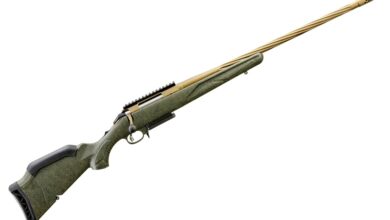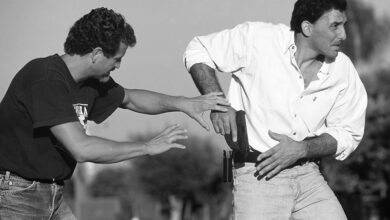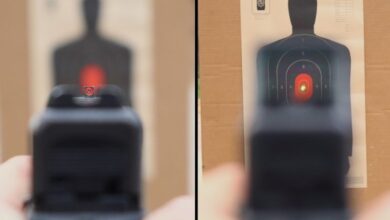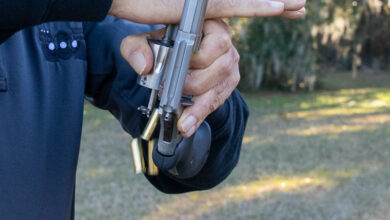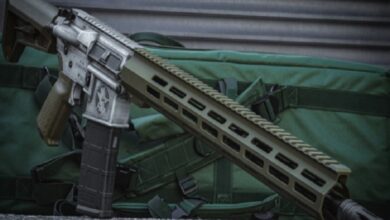The Ruger ReadyDot Versus the World

Pistol red dots are here to stay, and everyone and their mom is making one. Ruger dived into the space with a rather interesting take on the idea of a pistol red dot. The Ruger ReadyDot was designed to be sold separately and paired with the Ruger Max-9 pistol and took the idea of a pistol red dot and went a different route. The ReadyDot is a battery-free, adjustment-free optic designed to be dropped in and ready to rock and roll.
The ReadyDot is powered by fiber optics, which absorb light and power it. The dot itself is massive. It’s a 15 MOA dot that is massive compared to other options. The lack of adjustment turrets means it is presighted from the factory to be centered. In many ways, it’s designed to function as a fixed front sight, but it has the advantage of a red dot. When I read about ReadyDot, I was a bit doubtful.
It just didn’t seem like it worked well. You’d be giving up the ability to fine-tune your optic for total and complete accuracy. However, the massive 15 MOA red dot means more than likely something will hit where the dot sits. In my mind, that’s how it worked anyway. There was only one way to find out, and I reached out to Ruger, who was happy to send me one. The ReadyDot is a very simple optic, and that simplicity drives the price down to a $99 MSRP. It’s certainly an affordable take on the concept, but does it work?
The ReadyDot Versus the World
The Ruger ReadyDot uses an RMSc-style footprint, so it can be mounted to a wide variety of guns. I tossed it on my equally affordable Sig Sauer P322. The old .22LR is cheap and offers me plenty of opportunities to test and evaluate the optic. To do so, I took a series of drills and tests to see if a nonadjustable optic could be a functional defensive option.
The Failure to Stop Drill
Our first drill is the classic Failure to Stop, or Mozambique drill. This drill came from mercenary Mike Rousseau, and it’s based on an actual event he was a part of, which he retold to Jeff Cooper. Jeff Cooper incorporated the drill into the modern technique, and it’s still a popular training methodology. The drill can be fired from numerous ranges with numerous time restraints. I went for a two-second Mozambique drill. The drill consists of two shots to the chest and a well-aimed headshot.

My target of choice was an FBI Q target. It gives a reduced-sized chest and head target. I started the drill at fifteen yards and used a Pocket Pro 2 to record my time. Time turned out not to be an issue. I was able to fly through the first rep of a drill I’d fired several times before. My point of aim was the Q on the target. My second point of aim was the dead center in the head.
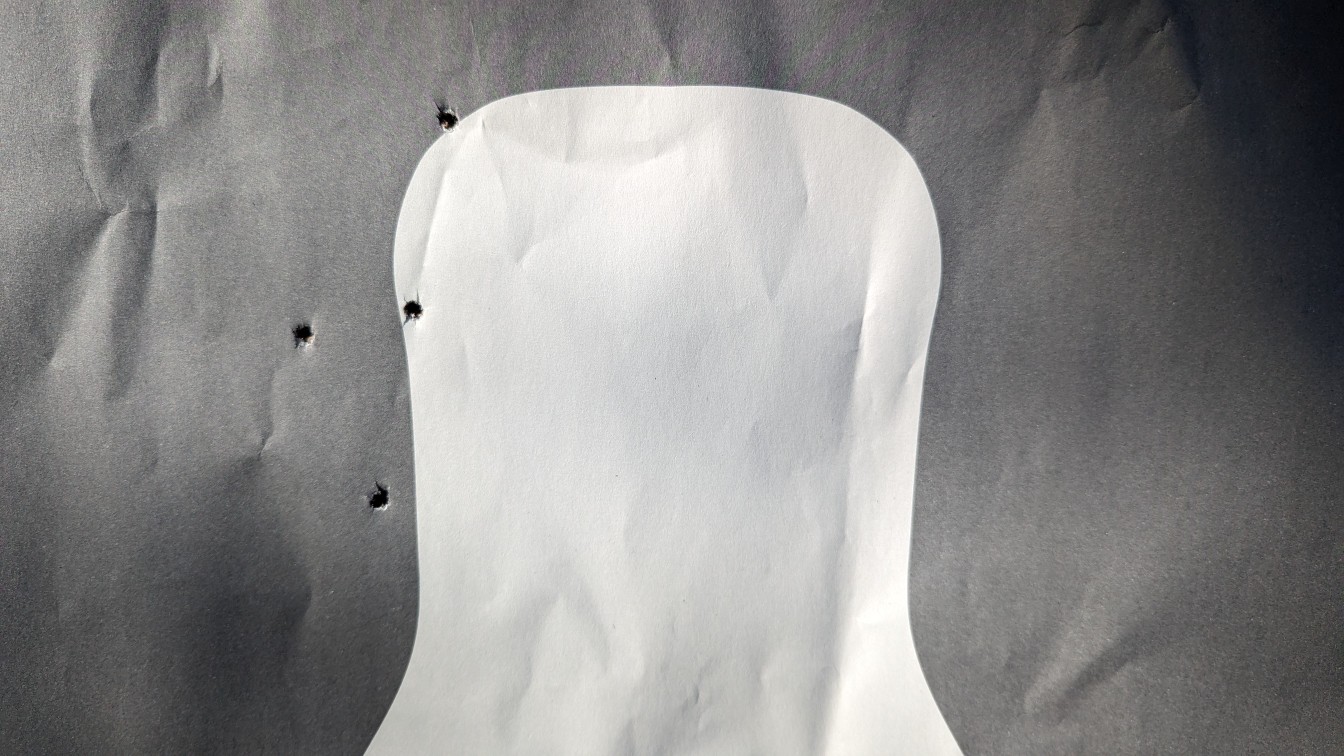
The rounds all landed to the left of the target. In fact, I completely missed the white of the target and landed shots in the gray for both the headshots and body shots. I ran the drill a few more times with Kentucky windage applied and landed my toros shots on target, but I barely landed a shot in the head.
The Bill Drill
The Bill Drill, named after its creator, Bill Wilson, is a very simple drill that applies well to red dot usage. It’s a drill that tests a shooter’s ability to get six rounds on target from the draw as fast as possible. The target is an IPSC-sized A Zone. The shooter must draw and fire six rounds into the A zone as fast as possible. There isn’t a pass/fail time, but excellent shooters can do this in under two seconds. (I’m not that fast…yet.)
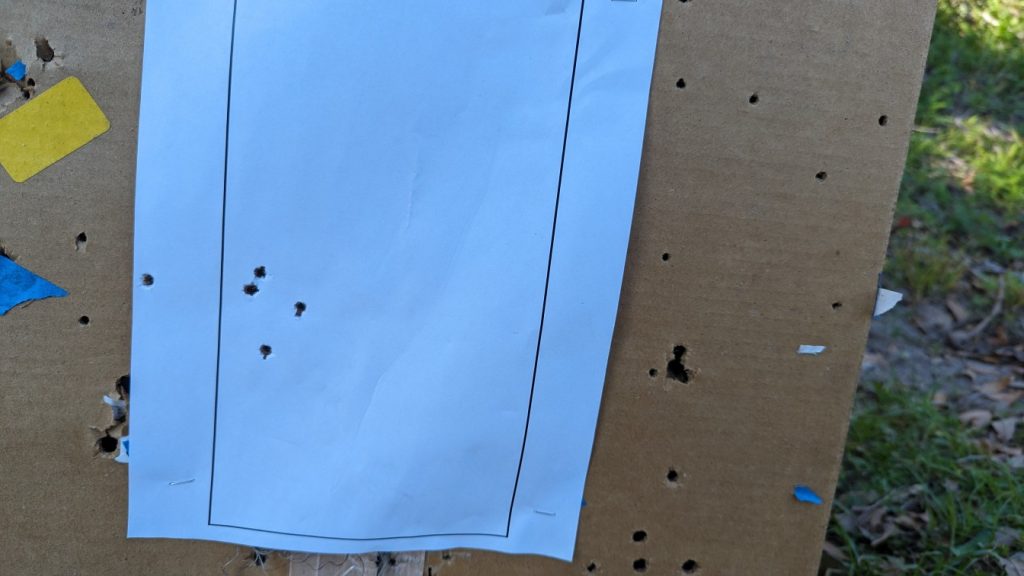
The A-zone provided a smaller target than the FBI Q, so I was interested in seeing how this would work out. On my first attempt cold, I landed four shots in the printed A-zone, one outside of it on paper, and one gone. All grouped to the left once more with a dead-center point of aim. Admittedly, two shots escaped my group, and that’s more on me failing to keep my grip consistent throughout the entire drill. I believe it was the first two shots I missed, and from the draw, I need to work on a good grip.
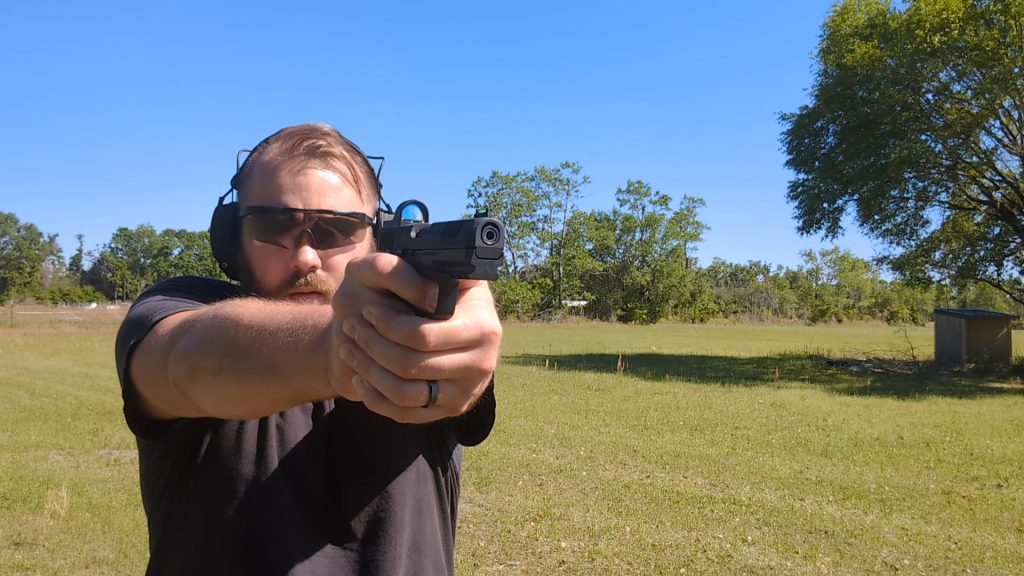
However, the four that hit were still fairly far to the left and just inside the rectangle. I fired several more Bill Drills with the Ready Dot, and they consistently grouped right to the left side of the rectangle. They were passable, with a 2.5-second average, but barely.
The 10-10-10 Drill
The 10-10-10 Drill has long been a great competency test for new shooters. The goal is simple: land ten rounds inside a B-8 in ten seconds at ten yards. You score by the numbers on the target and aim to accumulate 90 points out of a potential 100 points.

As soon as I drew and had my Ruger ReadyDot on target, I knew this one would be tricky. The massive 15 MOA circle made it impossible to see the black of the B-8. In fact, most of the target was covered entirely by the big reticle. Without pause, I let lose anyway and fired my ten rounds. All grouped to the left except one, which landed in the ten ring. That one ten was my last shot, and I purposefully moved my aim to the right because I needed at least one ten!
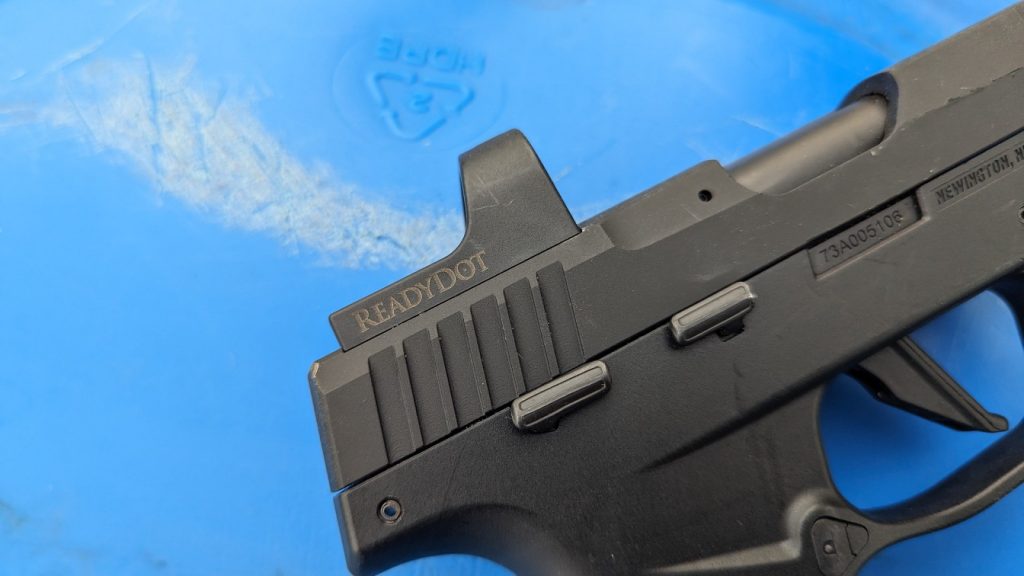
I scored an 86 on my first run. On subsequent runs, it depended on my point of aim. If I had aimed at the dead center, I might have passed, but it was tough due to the size of the dot. If I aimed slightly to the right, I passed every time.
Long Range Accuracy
One of the big advantages of a red dot is its ability to hit targets at longer ranges. I was fairly skeptical of how the ReadyDot would perform at longer ranges since it’s grouping so far to the left, even at close range, and the fact that the 15 MOA dot would cover so much of the target. I resigned myself to just being happy to hit an IPSC-sized steel target anywhere on the target, backed off to 25 yards, and held dead center on the larger portion of the target.
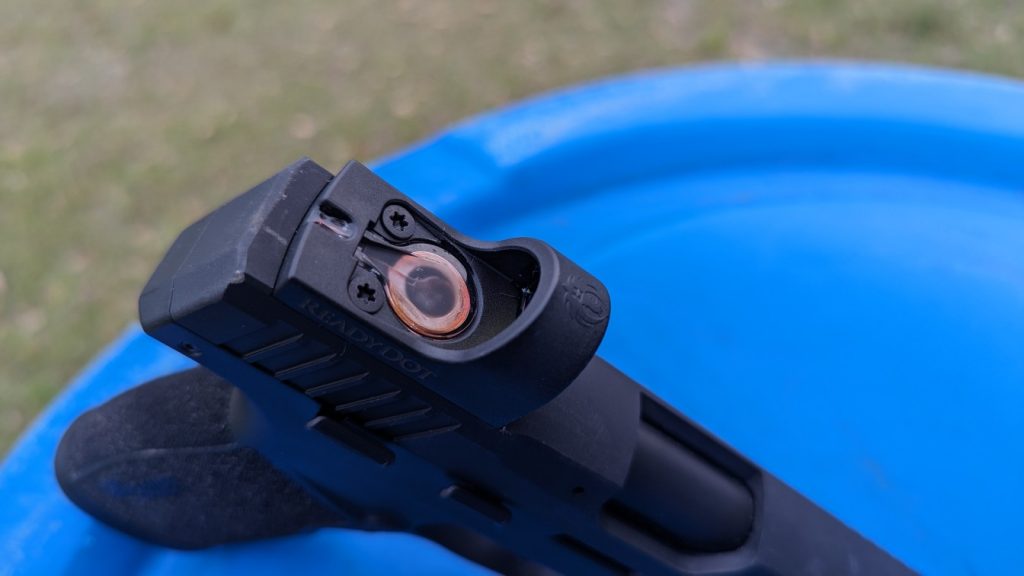
At 25 yards, with a dead-center aim, my shots would mostly hit the big target. If I adjusted to the right and aimed right of center, every shot hit. I backed off the 50 yards and sighted in dead center, but not a single shot landed. They all hit the dirt. I held to the right, somewhere between the target and the rightmost leg of the target stand.
Every round hit, and I sailed through the remainder of the magazine with a smile on my face. Even if I have to apply Kentucky windage, hitting a target at 50 yards with a handgun is always fun. Still, I had to aim pretty far off the target to score a hit.
Lighting Conditions: Dark to Bright
The brightness of the dot is regulated by the ambient light around the optic. It senses the light and adjusts as necessary. It works pretty well in most cases. As the light changes, the optic dims and brightens. In bright conditions, it gets super bright, and it is the most aggressive notch filter I’ve ever seen. It’s a deep, dark blue.
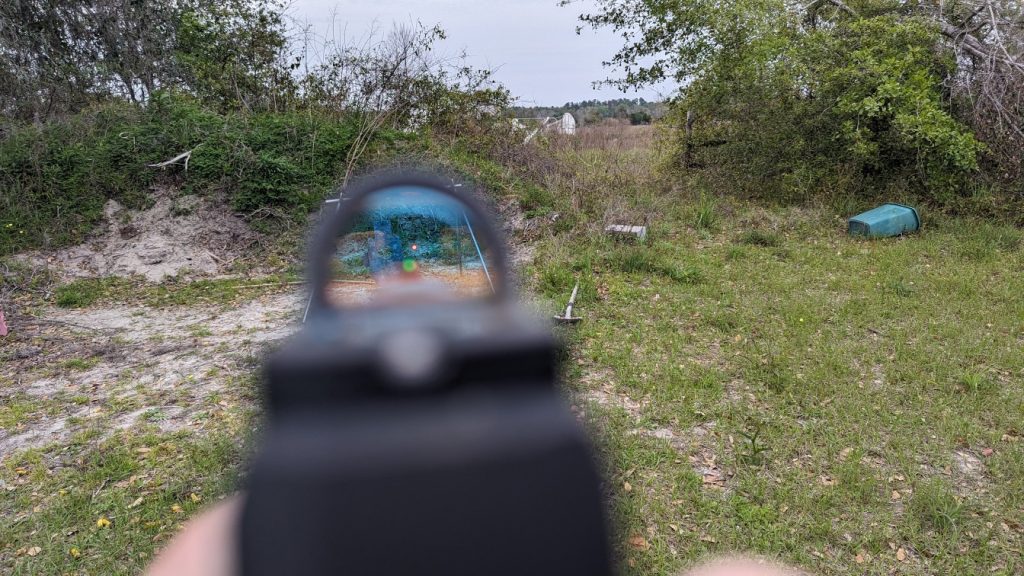
While it’s not a problem in most conditions, it’s tough to use when you are in a dark environment, and your target is in an illuminated environment and vice versa. It’s also tough to use under a weapon light. Indoors, the problems aren’t bad because the light reflects off the environment and brightens it. Outdoors are in the dark, and under a WML, they’re fairly useless.
Worth It
I’m torn on the Ruger ReadyDot. I don’t see it being used as the typical red dot sight we see on most handguns. To me, it’s more akin to an illuminated front sight rather than a red dot. For close-range instinctive shooting, it’s perfectly fine. As the range gap grows, we start to see its flaws. It sits low enough to co-witness with standard height optics, so on the right gun, like the Max-9, if the dot isn’t visible, you still have iron sights.
It does give you the speed of a red dot and the ability to use a target focus, but you won’t get the range and precision of a standard red dot. I’d prefer a standard red dot, but for a new shooter or someone not that interested in the skill of shooting, it would work. It might not be for me, but not everything is for me, either. Using a red dot of any kind is easier than iron sights, and this will likely make lower-skilled shooters better shooters without breaking the bank.
The post The Ruger ReadyDot Versus the World appeared first on The Mag Life.
Read the full article here

